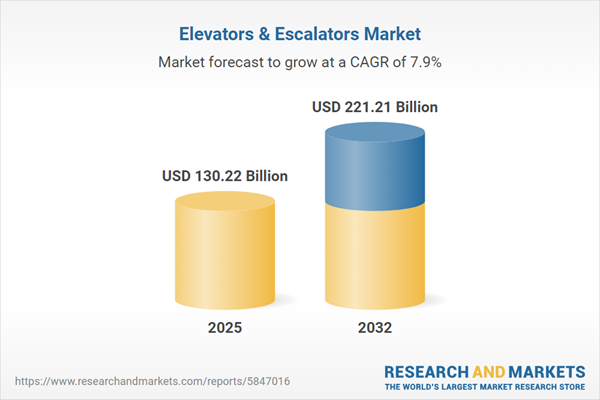Speak directly to the analyst to clarify any post sales queries you may have.
As urban landscapes evolve and regulatory environments shift, senior leaders in the elevators and escalators market are adapting their business strategies to keep operations resilient while navigating complex transitions in technology, compliance, and urban development.
Market Snapshot: Elevators and Escalators Market Size and Growth
The global elevators and escalators market is valued at USD 120.70 billion and is expected to increase to USD 130.22 billion within the year, indicating a robust CAGR of 7.86%. Long-term projections put the sector on course for USD 221.21 billion by 2032. This upward trajectory is influenced by ongoing urbanization and the need for high-rise mobility solutions, prompting companies to accelerate digitalization to bolster operational efficiency and compliance. Regions with significant infrastructure renewal, especially those adopting smart mobility and next-generation urban systems, are seeing marked growth in vertical transportation deployments and upgrades.
Scope & Segmentation: Elevators and Escalators Market
- Product Types: Passenger elevators that support accessibility, freight elevators for logistics, hospital elevators optimized for healthcare environments, home lifts catering to residential mobility needs, and escalators or moving walkways for managing flow in retail, public, and transit locations.
- Installation Types: Service includes maintenance for operational continuity, modernization to enhance safety and asset value, and new installations spanning office, industrial, commercial, and residential facilities.
- End Users: Commercial offices, retail hubs, hospitality sites, infrastructure projects, industrial complexes, and residential properties, each with unique requirements for mobility and occupant experience.
- Technology: Hydraulic and traction systems utilizing geared, gearless, and machine room-less platforms, with the sector moving toward digital integration for performance tracking and optimization in both legacy and smart buildings.
- Speed: Solutions address needs from high-traffic commercial environments to low-density settings, maintaining mobility and safety across diverse building typologies and population levels.
- Application: Equipment designed for metro hubs, isolated sites, and a variety of climatic and regional conditions ensures global reliability and adaptability for vertical movement.
- Geography: Active regions include the Americas, Europe, Middle East & Africa, and Asia-Pacific, with the United States, Brazil, Germany, UAE, China, and India reflecting differences in regulation, infrastructure priorities, and market maturity.
- Key Companies: Leading providers such as Otis Elevator Company, Schindler Holding AG, KONE Corporation, TK Elevator GmbH, Mitsubishi Electric Corporation, Hitachi Ltd., Fujitec Co. Ltd., Hyundai Elevator Co. Ltd., Toshiba Elevator and Building Systems Corporation, and Canny Elevator Co. Ltd. demonstrate strong project management capabilities and service reach.
Key Takeaways for Senior Decision Makers
- Demand for scalable mobility solutions underpins strategies for mixed-use developments, commercial growth, and urban housing expansion in fast-changing cities.
- Digital platforms leveraging IoT and AI advance predictive maintenance and asset oversight, reducing unplanned outages and supporting cost-effective property management.
- Sustainable procurement and efficiency objectives are gaining focus as organizations seek to future-proof assets and achieve environmental standards.
- Ongoing compliance with evolving safety requirements is critical, helping to safeguard operational continuity as oversight intensifies globally.
- Close partnerships with technology suppliers and engagement with regulators streamline the adoption of innovative systems and minimize risk during transitions.
- User-focused design priorities are influencing building projects, as expectations for enhanced accessibility and seamless experience rise among occupants and visitors.
United States 2025 Tariff Impact
Ongoing tariffs on steel and aluminum are driving up procurement costs and introducing complexity for U.S. elevator and escalator manufacturers. To address these challenges, senior leaders are broadening supplier networks, reviewing domestic manufacturing opportunities, and adopting new supply chain management practices. Strategic evaluations underway include renegotiation of supplier agreements, inventory realignment, and greater vertical integration. These measures are intended to strengthen the industry’s resilience and reduce exposure to regulatory shifts and trade volatility.
Methodology & Data Sources
This market evaluation incorporates direct input from manufacturers, facility managers, and procurement leaders. Findings are enhanced by comprehensive industry surveys and regulatory data reviews, and independently validated by third-party organizations to confirm reliability and accuracy.
Why This Report Matters for Strategic Leaders
- Equips executive teams to adapt to changing regulations and sustain operations through dynamic market cycles.
- Enables better investment and allocation decisions via granular segmentation, technology insight, and robust benchmarking.
- Provides actionable frameworks for integrating sustainability and compliance across all stages of the vertical transportation ecosystem.
Conclusion
This report delivers validated insight and actionable guidance to support resilient planning and decisive, future-focused strategies for senior decision makers in vertical transportation.
Additional Product Information:
- Purchase of this report includes 1 year online access with quarterly updates.
- This report can be updated on request. Please contact our Customer Experience team using the Ask a Question widget on our website.
Table of Contents
3. Executive Summary
4. Market Overview
7. Cumulative Impact of Artificial Intelligence 2025
Companies Mentioned
The companies profiled in this Elevators & Escalators market report include:- Otis Elevator Company
- Schindler Holding AG
- KONE Corporation
- TK Elevator GmbH
- Mitsubishi Electric Corporation
- Hitachi, Ltd.
- Fujitec Co., Ltd.
- Hyundai Elevator Co., Ltd.
- Toshiba Elevator and Building Systems Corporation
- Canny Elevator Co., Ltd.
Table Information
| Report Attribute | Details |
|---|---|
| No. of Pages | 190 |
| Published | October 2025 |
| Forecast Period | 2025 - 2032 |
| Estimated Market Value ( USD | $ 130.22 Billion |
| Forecasted Market Value ( USD | $ 221.21 Billion |
| Compound Annual Growth Rate | 7.8% |
| Regions Covered | Global |
| No. of Companies Mentioned | 11 |









